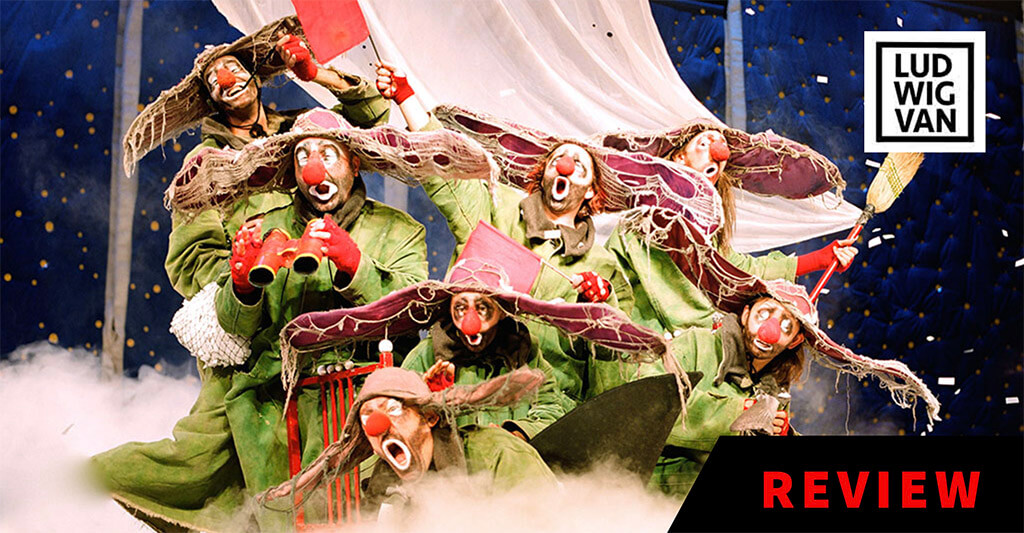
Civic Theatres Toronto & Show One Productions/ Slava’s Snowshow, created by Slava Polunin, directed by Viktor Kramer, designed by Viktor Plotnikov, Bluma Appel Theatre, Dec. 7 to Dec. 16, 2018. Tickets available at (416-345-9200) or www.ticketmaster.ca.
Clown shows are not for everyone. Despite the whimsy, they are inherently sad, and sometimes downright scary, but they are also profound representations of the human condition. At their funniest moments, they help us find our inner child and the lost innocence of youth. It is, however, in their tragicomedy elements that we recognize the emotional rollercoaster that we experience every day of our lives. Slava’s Snowshow is all these things and more.
The last time this famous Russian production visited Toronto was in 1998, and yet I remember the chaotic joy of the finale (which I will not reveal), as if it were yesterday. The main question is this: how does a show stay fresh for decades without going stale over time? The answer is really simple. The images that Slava’s Snowshow parades across the stage are universal. This is a show basically without words. The continuous score, a mix of popular and classical music, functions like a cinema soundtrack, underlying the shifting moods of the clownscape. Visuals can travel the globe, surmounting the barriers of language.
Slava Polunin is one of Russia’s most famous clowns, and his alter ego Asisyai is much beloved in that country and around the world. Asisyai is characterized by baggy yellow overalls, a red scarf, oversized fluffy red slippers, a white beard, a half bald head with stringy white hair, and a droopy red nose. Instead of clown whiteface, Asisyai’s eyes are ringed with black smudges giving him a world-weary air. His movements are slow and deliberate. During the course of Slava’s Snowshow, we follow Yellow Clown (as he is called) on a journey through the dark night into the gathering storm.
Yellow Clown is not alone on stage. On his journey, he is bedevilled by Green Clown — six of them, in fact — who tease, torment, shadow, and yes, even befriend Yellow Clown when it suits them. The beanpole Green Clown leader (Robert Saralp) mirrors Yellow Clown, giving back to him a picture of himself. He is also the sounding board that Yellow Clown plays off of. Green Clown is both an instigator and provocateur.
All Green Clowns are dressed the same. They sport the traditional clown makeup including the round red nose and the “surprise” white circles that surround the eyes and mouth. Everything about Green Clown is long — the long green coat, the hat with long, stiff horizontal flaps, and the black shoes with very elongated toes. Where Yellow Clown is cautious and careful, the Green Clowns are more madcap and playful.
The set is made up of blue quilts with a quarter moon hung on them. At the end, they are reversed to show their pure white side, a backdrop for the snowstorm. At one point, a Green Clown pulls a sled carrying three little houses with warm, inviting light inside — a symbol of what we strive for. The Snowshow itself is a metaphor for the cold wide world we have to cope with, and by the end, the audience is covered in slivers of tissue paper that represent the snow. The production itself is a series of vignettes, several of them belly laugh funny, but many of them melancholy, even when they are humorous. And yes, there is interaction with the audience, which can be both hilarious or irritating, depending on your disposition.
The first image is all-important because it sets the main theme. Yellow Clown comes out carrying a rope with a noose. He pulls and pulls on the rope, until he pulls out Green Clown, also with a noose. A rope with two nooses. Yellow meets Green, and the game is in play. Another time, Yellow Clown comes on stage shot through with arrows and performs a very funny death scene. He is followed by Green Clown carrying a bow and arrow, and looking rather embarrassed. Then there is the vignette where Yellow Clown tries to hold his balance on a chair that slopes dangerously to the side, leading to a pure slapstick pratfall, but then, that’s life, full of tilted chairs and tables. In this production, sad and funny become interchangeable.
If I had to sum up Slava’s Snowshow in one word, I would say moving. The plight of Yellow Clown does touch the heart, and while we appreciate the sunny disposition and sly humour of the Green Clowns, it is the melancholy journey of Yellow Clown that is the true reality. The many children at the performance seem to intuitively understand that. The clowns — both Yellow and Green — draw us into their world, at once childlike with wonder, but tinged with anxiety.
During the frenzied intermission with the Green Clowns dispensing their mayhem, they also give out hugs. I was lucky to get one of the hugs, and it felt really good.
- INTERVIEW | Actor Diego Matamoros Takes On Icon Walt Disney In Soulpepper Production Of Hnath Play - April 16, 2024
- SCRUTINY | Opera In Concert Shine A Light On Verdi’s Seldom Heard La Battaglia Di Legnano - April 9, 2024
- SCRUTINY | Lepage & Côté’s Hamlet Dazzles With Dance And Stagecraft Without Saying Anything New - April 5, 2024



